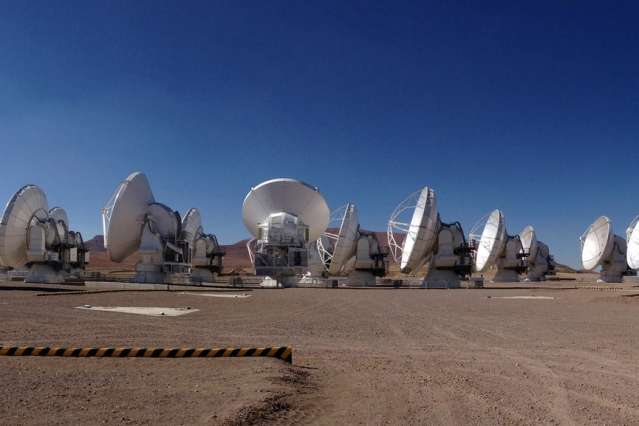The ALMA array in Chile joins global VLBI arrays for unprecedented leap in resolving power

A powerful new array of radio telescopes is being deployed for the first time this week, as the Atacama Large Millimeter/submillimeter Array (ALMA) in Chile joins a global network of antennas poised to make some of the highest resolution images that astronomers have ever obtained. The improved level of detail is equivalent to being able to count the stitches on a baseball from 8,000 miles away.
Scientists at MIT and other institutions are using a method called VLBI (Very Long Baseline Interferometry) to link a group of radio telescopes spread across the globe into what is, in effect, a telescope the size of our planet. Although the technique of VLBI is not new, scientists have just recently begun extending it to millimeter wavelengths to achieve a further boost in resolving power. And now, the addition of ALMA to global VLBI arrays is providing an unprecedented leap in VLBI capabilities.
The inclusion of ALMA was recently made possible through the ALMA Phasing Project (APP), an international effort led by the MIT Haystack Observatory in Westford, Massachusetts, and principal investigator Sheperd Doeleman, now at the Harvard–Smithsonian Center for Astrophysics.
Before this project, the ALMA dishes worked with each other to make observations as a single array; now, the APP has achieved the synchronizing, or "phasing," of up to 61 ALMA antennas to function as a single, highly sensitive radio antenna—the most antennas ever phased together. To achieve this, the APP team developed custom software and installed several new hardware components at ALMA, including a hydrogen maser (a type of ultraprecise atomic clock), a set of very-high-speed data reformatters, and a fiber optic system for transporting an 8 gigabyte-per-second data stream to four ultrafast data recorders (the Haystack-designed Mark6). The culmination of these efforts is an order-of-magnitude increase in the sensitivity of the world's millimeter VLBI networks, and a dramatic boost in their ability to create detailed images of sources that previously appeared as mere points of light.
"A great many people have worked very hard over the past several years to make this dream a reality," says Geoff Crew, software lead for the APP. "ALMA VLBI is truly going to be transformative for our science."
One of the goals of these new technological innovations is to image a black hole. This month, two international organizations are making observations that will allow scientists to construct such an image for the very first time. And the portrait they're attempting to capture is close to home: Sagittarius A* (Sgr A*), the supermassive black hole at the center of the Milky Way.
So much data will be collected during the two observation periods that it's faster to fly them to Haystack than it would be to transmit them electronically. Petabytes of data will be flown from telescopes around the world to Haystack for correlation and processing before images of the black hole can be created. Correlation, which registers the data from all participating telescopes to account for the different arrival times of the radio waves at each site, is done using a specialized bank of powerful computers. MIT Haystack is one of the few radio science facilities worldwide with the necessary technology and expertise to correlate this amount of data. Additional correlation for these sessions is being done at the Max Planck Institute for Radio Astronomy in Bonn, Germany.
Two observing sessions are taking place. The GMVA (Global mm-VLBI Array) session will observe a variety of sources at a wavelength of 3 millimeters, including Sgr A* and other active galactic nuclei, and the EHT (Event Horizon Telescope) session will observe Sgr A* as well as the supermassive black hole at the center of a nearby galaxy, M87, at a wavelength of 1.3 millimeters. The EHT team includes researchers from MIT's Haystack Observatory and MIT Computer Science and Artificial Intelligence Laboratory (CSAIL), working with the Harvard-Smithsonian Center for Astrophysics and many other organizations.
"Several factors make 1.3 mm the ideal observing wavelength for Sgr A*," according to APP Project Scientist Vincent Fish. "At longer observing wavelengths, the source would be blurred by free electrons between us and the galactic center, and we wouldn't have enough resolution to see the predicted black hole shadow. At shorter wavelengths, the Earth's atmosphere absorbs most of the signal."
The current observations are the first in a series of groundbreaking studies in VLBI and radio interferometry that will enable dramatic new scientific discoveries. Data from the newly phased ALMA array will also allow better imaging of other distant radio sources via improved data sampling, increased angular resolution, and eventually spectral-line VLBI—observations of emissions from specific elements and molecules.
"Phasing ALMA has opened whole new possibilities for ultra high-resolution science that will go far beyond the study of black holes," says Lynn Matthews, commissioning scientist for the APP. "For example, we expect to be able to make movies of the gas motions around stars that are still in the process of forming and map the outflows that occur from dying stars, both at a level of detail that has never been possible before."
The black hole images from the data gathered this month will take months to prepare; researchers expect to publish the first results in 2018.
Provided by Massachusetts Institute of Technology
This story is republished courtesy of MIT News (web.mit.edu/newsoffice/), a popular site that covers news about MIT research, innovation and teaching.




















